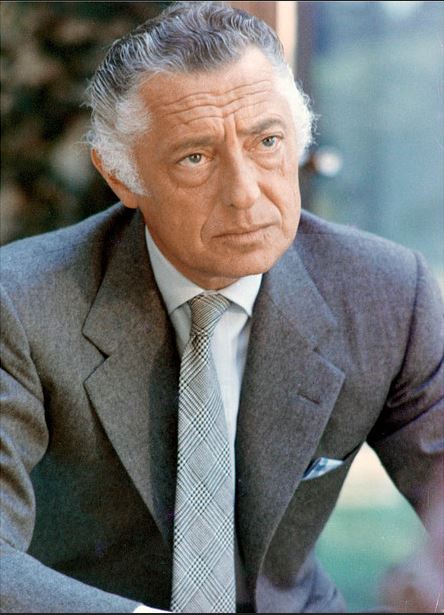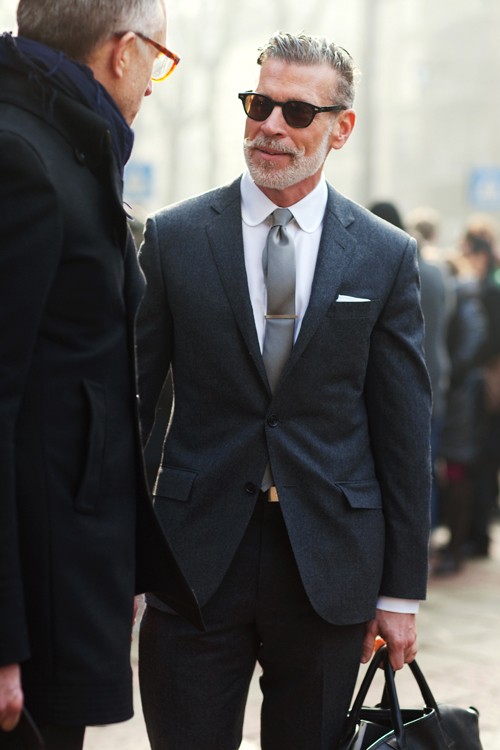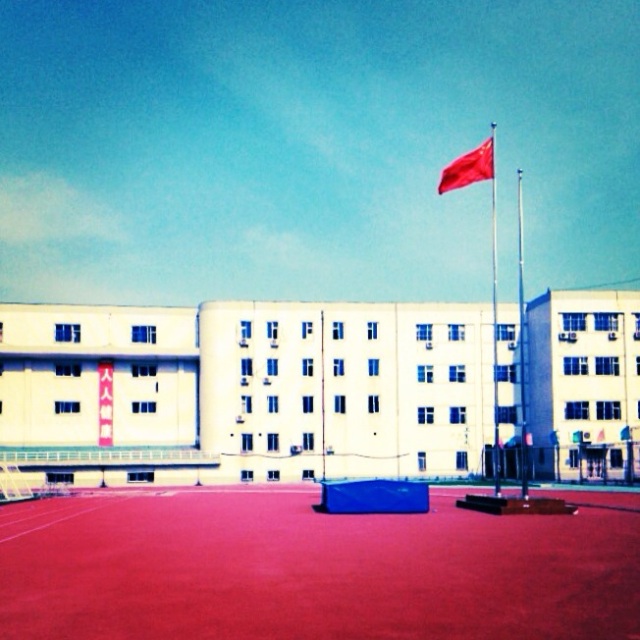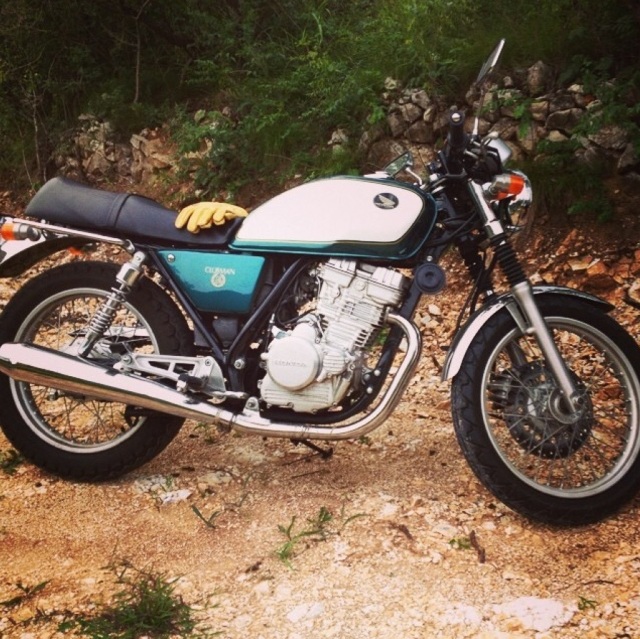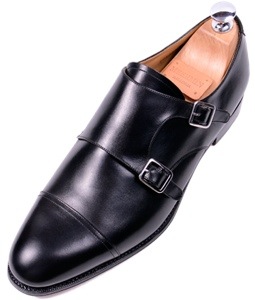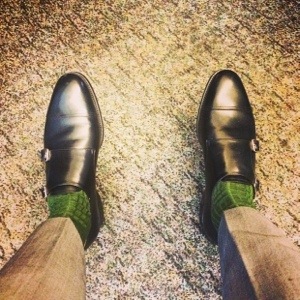Fall and winter flannels at Principle M include Scabal, Vitale Barberis Canonico, Marzoni, and Tessitura diQuaregna.
Principle M Popup Shop at Four Seasons Hotel Beijing
Metamorphosis of the New Renaissance Man
The term “Renaissance Man”, originally referring to cross-discipline geniuses such as Leonardo da Vince and Michelangelo, has been given a brand new meaning in the current age. With the aid of information technology, we are able to get access to past imagery like never before, and hence create a virtual nostalgic world that is new and old at the same time. The New Renaissance Man no longer crosses disciplines but rather time and space.
In an installation from September 10 through September 21, Principle M together with Radiance Blue will weave through the nostalgic world of the New Renaissance Man to present to you the best of menswear through the ages.
I’m more than thrilled to announce Principle M’s first popup shop in collaboration with Radiance Blue at the Four Seasons Hotel in Beijing (Principle M; first made-to-measure label in Beijing that provides image consultation alongside our tailoring services [I’m a co-founder, more on that later]. Radiance Blue; leading boutique in vintage Americana lifestyle in China).
We will host a series of daily workshops by Beijing’s most talented craftsmen, niche Scottish whiskeys will be served at the workshops and of course Principle M and Radiance attire is up for sale.
It has been a fun collaboration planning and designing our installation with Radiance and Four Seasons and of course a ton of hard work from all hands involved. Next step is execute and launch. For now here are some teasers on the installation design, our F/W lines and a blurb or two.
A real gentleman refuses to be constrained by rules. To know and to break the rules, is the only path to true elegance. The fine dandies throughout history, from Beau Brummel to Gianni Agnelli, have all earned their name through revolutionizing the way men dress. At the present day, the spirits of these forerunners of dandyism have revived through digital images, keeping alive the essence of elegant non-conformity in an age of industrial standardization.


The motorcycle may be the perfect hybrid of the classical and the mechanical age. The mechanical beast is ridden in an almost equestrian position, requiring a close relationship between man and machine akin to that of rider and horse. Here the traditional meaning of Renaissance man is revived: only one who understands both aesthetics and mechanical engineering could master the art of motorcycle.
If you are in or around Beijing, come by the popup anytime from 8am to 10pm. Workshops will be announced daily, RSVP required; social@principlem.com
3 steps to get your Chinese driver’s license
Believe it or not, you need a license to drive on the roads in China–and international driver’s license are not valid in the People’s Republic of China. So, you have to go through the lovely process of getting a driver’s license in China if you would like to drive legally. The process has some lovely Chinese characteristics, so here it is:
Kota Kinabalu: 5 Do’s and 5 Don’ts
In case you are planning a trip and wanted to get the low-down on Kota Kinabalu (KK), here is a list of do’s and don’ts based on my experiences.
THE DO’S
1. Island hop. There isn’t much of a beach around Kota Kinablu other than a poor excuse of a man-made beach at a few of the resorts. Jesselton Pier in town can arrange for day trips or if you stay at a resort they can also provide boat services (but twice the price and goes to islands half the distance)
2. Eat. Local. Food. It’s f#@cking cheap and delicious. There was a wide range of Indian infused foods to Cantonese fused–i guess this is known as Malaysian food. A meal for two at these joints never went over $10 bucks. Here are a few recommendations:
Yee Fung off of Jalan Gaya was visited on more than one occasion. Their Laksa is amazing–its the perfect blend of spices and ingredients to keep my attention to the last drop.The beef noodles reminded me of Pho, which is always comforting. Their clay pot chicken rice is also notable but was in the shadow of the Laksa. On another occasion we mixed in a bowl of wonton noodles made dry (noodles and wontons come separate, noodles dry and wontons wet) and the texture of the egg noodles were chewy and saucy to my liking. Have your choice of a vegetable as a side–it will be doused in oyster sauce. You can wash all this down with a Kopi O–strong and a-bit-too-sweet instant black coffee–or what I preferred; 拉茶 (la cha) a foamy iced milk tea.
Maimuna is 24/7 and always serving up goodness. We went for their Roti Canai and Mee Goreng Seafood. The taste and textures of the Mee Goreng have me intrigued; I might try my hand at recreating this dish in the near future. I saw they had 2 locations, on the same street. They also have a buffet style offering of indian style curries. You get a plate of rice and get to attack the buffet.
Kedai Kopi Fatt Kee at Ang’s Hotel was a comforting twist of local Cantonese dishes. The sweet & sour shrimp and oyster sauce chicken wings came with a dash of nostalgia for my dad’s food (Cantonese language and the overwhelmingly comforting sounds of a Cantonese kitchen added to the nostalgia as well). I was tempted to order more wings, but decided to save some room incase I came across something interesting that needed to be tasted.
There are dozens of other options but we always found ourselves super hungry and without the patience to search for another place to grub. Just walk around town and find a place that is busy and order the first item on the menu.
3. Take an afternoon to explore the craft market, spice market and of course the wet market. Start off at the spice market since it closes somewhat early, then venture into the craft market to pick up some gifts and after five, venture into the wet market–which is the real reason I ventured to these markets; fresh seafood made to order. In fact, I didn’t even go into the craft market or spice market (I live in Beijing and frequent markets like this often). Tiger prawns and fresh fish were the main items up for order. The guy grilling up goodness, was as much a salesman as he was a cook. He convinced us to get three of the giant prawns and one in each flavor; chili, garlic butter and plain. I was a bit reluctant as I’m not a big fan of Tiger Prawns since they are usually chewy and tough but I wanted to try out the different styles. The cook threw them on the grill. I ordered a Tiger beer to wash down the tiger prawns and in the meantime I ordered some grilled chicken wings from the next stall. I also grabbed a square fried delight (didn’t catch the real name), which was made using fresh dough pulled paper thin and the size of a laptop then dropped in hot oil, then a filler of cabbage and other vegetables was dropped in the center and then the edges were folded over to make a square. The wings were sweet and savory and I was tempted to grab a few more but the Tiger Prawns landed on our table. They were good but not great. As expected they were tough and unfortunately nothing special as I was expecting a local twist on these to blow me away. In fact, I was a bit let down by the limited offerings of made to order seafood (essentially just Tiger Prawns and a couple varieties of fish) and the limited styles they offer to prepare. The prawns were about $10 a pop. The beer was also about $10. The wings were a couple bucks for a half dozen and the fried delight was under $1.
4. Climb Mount Kinabalu. You can do a 3 day 2 night trek, 2 day 1 night trek or even a 1 day climb to summit the 4095m mountain. Unfortunately, my time was limited in KK and I had to make a choice: scale the beast in a day or don’t or don’t climb it at all. The choice was simple really–what’s the point in exhausting yourself racing up a mountain in one day? To achieve an egotistical accomplishment? Naw. I’d prefer to climb slow, spend a night on the mountain and take in all that the mountain has to offer. Next time, Mount Kinabalu! (book your climb in advance here since they cap the number of climbers per day. So book ahead!)
5. Sunsets in KK are amazing.
THE DON’TS
1. Do some due diligence on the islands you are hopping to. We over-paid, or as I tell myself ‘paid for convenience’ through our resort to go island hopping to do some snorkeling and beach bumming. If we had more tme, I would have gone to islands further out via Jesselton Pier (I heard Police beach is good).
2. Don’t expect KK to be a beach town for bumming around. I think there are 2 types of travelers here: the backpacker in transit to/from Mount Kinabalu and the various other (diving) destinations in Sabah or a vacationer doing the resort thing.
3. Eat. Local. Food. If you are staying at a resort, don’t eat at the crappy restaurants that are over-priced at your resort, get out to town and eat at the first joint you see that is busy with locals. The same goes for backpackers–don’t eat the shitty banana pancakes that they serve at your hostel! Get out and eat the local stuff. You will probably save money too, you cheap backacker!
4. Don’t sleep in. Get up early and get out. It was monsoon season which meant daily rain. The rain usually started between noon and three an lasted a couple hours–perfect time for a nap and rest from the sun. The mornings however, were beautiful!
5. Don’t drink too much. Malaysia is an Islamic state and here is a 100% tax on alcohol—I’m not sure if those go hand in hand or not… Anyways, that means you will be paying double for any kind of drink and you should always try to respect local culture.
Sneak Peak @ Mount Emei | 峨眉山
In early July I went to Chengdu on a last minute trip to scale 峨眉山 (E’mei shan | Mount Emei 3099m) and found ourselves having to sneak to the peak. Very little planning went into this trip, which is how I like this kind of adventure. If you don’t plan much, you don’t set expectations and you can let the mountain work its magic. Just make sure you don’t miss the peak–you kind of have to sneak your way through to 万佛顶 (Wan Fo Ding), the highest peak at 3099. 金顶 (Golden Summit 3079m), isn’t actually the highest peak, but is where climbers are led to and then told the path is closed off to Wan Fo Ding. So read on or skip to the bottom to find out how to get to Wan Fo Ding, which is closed off.
I flew into Chengdu on a Sunday morning to meet my good friend Paul who loosely planned the climb. Paul has over 8 years of China experience under his belt and practices esoteric buddhism–probably nobody better to climb a mountain covered in temples with. We’ve gone on a few rides in the mountains surrounding Beijing and shared many meals together. He is currently studying in Alaska, where he is from, but made a last minute summer trip for a ceremony in Chengdu. It just so happened he had a few extra days and wanted to climb Mount Emei (for his second time) and invited me to come along.
I must say, there were many obstacles from keeping us from Emei Shan, which made it all the more desirable. First, I met Paul at his hostel in Chengdu on a clear but hazy day. The people working at the hostel advised us not to go to Emei Shan because they received reports it was closed off due to torrential downpours. We went to catch the two hour train anyways. (We bought our tickets for the train around noon on Sunday for a 6:30pm train. There were no seats available, only hard sleepers for about $12 USD. We booked the tickets. You can also catch a bus which takes a bit under 3 hours for a couple bucks.
We found ourselves sprinting to the train. I guess we lost track of time enjoying what Chengdu had to offer. We just made the train, settled into our hard sleepers and tried to doze off. About 45 minutes into the ride, the train hit the brakes abruptly and I found myself up against the wall. Yikes. I was in the 11th car and had no idea what was going on. I noticed people outside were running towards the front of the train, but not much else…About 30 minutes later we started up again. As we passed where the front of the train would have been, I noticed hundreds of people gawking around an area where there was a hole in the fence that blocked off the tracks…
We arrived at our stop in Le Shan then found a black cab to take us to the base of the mountain for about 25 RMB. We stayed at the Teddy Bear Hostel which was superbly clean and $15 bucks for a double room. As we were checking in at around 10pm, we also bought tickets to the local hot water springs which were just up the road (125 RMB and I HIGHLY recommend it). We anxiously soaked up in the hot springs, which was designed more like a small water park. Midnight struck and the hot springs closed. We went back to our room and I watched USA lose against Germany in world cup as I fell asleep. Meh…
***
We woke at 7-something and headed out of the hostel and started hiking. Last time Paul scaled Emei Shan in 1 day starting from Wan Nian Temple up to the Golden Summit, a trek that is about 20km from base to summit. This time, we wanted to spend more time hiking and taking it all in and spend 1, maybe 2 nights on the mountain. We decided we would hike to Baogou Temple, head to Qingyin Pavilion, then over to Xiangfeng Temple, cross over to Elephant Bathing Pool, then make a straight shot to the Golden Summit, a total of about 45km.
As we started to make our way up and arrived at the main entrance and ticket hall, sure enough the mountain was closed off. But not due to weather. There was a sort of disagreement between the local villagers and the folks who usually wear dark boxy suits, red ties and lapel pins (not naming names as I don’t want to have my blog blocked in China). The entry was completely blocked off–not just a swing arm down and a sign saying closed, but imagine a small gang of villagers that wouldn’t allow us to pass. Again, we found the forces fighting against us. There was no way we were going to head back to town, we were determined to get up the mountain. We started walking back and a Chinese guy walked next to us and whispered to us in broken English “if you go back 150 meters, there are a few buildings on the hilside and a staircase between the two. Go up the staircase.” We found the staircase and headed up. We were on our way to what seemed to be a dated trail up the mountain. On the main path there are concrete or stone steps the entire way up. We got a little lost on the broken trail but after 2-3 hours and 10-15km, we found the main trail. By the time we found it, there was a slight sense of relief by both of us.
For the next 20-25km and about 10 hours we hiked up and down, through spruce forests and bamboo forests. On paths and off paths. We came across mountain streams and several temples. The best thing is we maybe ran into a half dozen other tourists, which is unheard of during summer months in China where most tourist attractions and mountains are littered with tourists. I guess ‘torrential rains’ were enough to scare most people away.
There are a dozen or so temples on the mountain and you can sleep at any of them for about 50rmb. The idea was to hike as high as possible, get some sleep but rise before dawn and hike to the summit to catch the sunrise. That didn’t happen. We made it to Elephant Bathing Pool Temple (洗象池) around 10pm at just over 2000m. Just before we arrived there, there was a villagers kitchen on the hillside who happily announced in Chinese “you made to to Elephant Bathing Pool! Eat here because there isn’t anything to eat up there.” We ordered a mountain chicken in YinYang soup, some eggplant, morning glory and a couple beers. It was almost dreamlike. Here we are, 2000m+ up Emei Shan in the pitch dark and there is a restaurant and beers. After eating, we climbed a few minutes and arrived at the footsteps of Elephant Bathing Pool Temple. It was dark, but the little light that was shining over the temple walls was inviting and had a dream like aura. We got a room and our beds had heated blankets, there were power outlets, drinking water and HOT showers! After climbing over 10 hours and around 20-25km through hot humid climates to cooler damp weather in higher elevation, I wanted nothing more than a hot shower.
The next morning I woke to the relaxing sound of monks chanting mantras and prayers. I rolled out of my cozy heated bed to crisp, clear refreshing air and this view:
I wanted to just hang out at this temple all day. It was amazing. But we had the urge to carry on and make it to the top. Just above the temple was another restaurant, which is where we had breakfast. A couple monkeys dropped in on our outdoor seating so we had to move inside. Be careful, the monkeys are hungry and want your food. They will take it if you aren’t cautious. They will even rip into your backpacks or bags to find food.
About 7km from the top, there is a road that leads from the base up. This is where we ran into the crowds of tourists. The majority of them take a bus up, then the option of a chair lift or hiking the last leg. Finally, we made it to the Golden Summit (3079m) which has a golden temple, a silver temple and elephant statues. Pretty cool.
I guess we were also lucky with weather. Usually the top is covered in fog and clouds. We had some blue sky and a clear floor and ceiling of clouds. We were content that we made it to the top and were thinking of the hot springs already. However, there was the other summit in the distance. We made it this far, we better make it to the Wan Fo Summit (3099m).
We hiked along a trail that we thought lead to Wan Fo Summit but it looped around and led to a closed off monorail. It appeared that Wan Fo Summit was closed off. We asked around and people said it was closed. We started to head down the mountain. We asked one more person if it was possible to get to Wan Fo Peak and they said there was a trail behind the hotel at the top. We walked around the back of the hotel and sure enough, there was a trail that led along the Monorail.
We walked on the monorail (which I wouldn’t recommend) to avoid the prickly shrubs and muddy path. The monorail usually ran one to two meters above ground but at one point was about 10 or so meters above ground. Creepy and sort of stupid. Anyways, we came up to the temple and Wan Fo Summit and didn’t see another person along the way. Peaceful and surreal. The track and temple reminded me of the animation film Spirited Away.
If we never made it to Wan Fo Peak, I think I would have had some regrets. I’m glad we snuck our way to this peak as the feeling of accomplishment was great and the view was priceless. I’m starting to understand and enjoy why hiking mountains is so popular…
FLAG FOOTBALL
Cold Pressed Coffee
I admit, I’m addicted. There is something about coffee and I’m not sure if its the ritual of making my own cup of joe in the morning or the caffeine dose that keeps me hooked. Either way, I am getting kind of bored with a standard drip coffee in the morning and it doesn’t help that it’s HOT this summer.
I was inspired to try my hand at cold pressed coffee from a photo I saw on Instagram. So here is my recipe and brewing method (hint: it is super easy!):
Ingredients and what you need for the brew:
- *1 Cup ~ 225g coffee beans–coarsely ground
- *3 Cups ~ 700ml water
- French Press
- Coffee filter cone (paper cone)
- Drip coffee machine (not needed but will make it easier, you will see why)
*you can adjust to your preference the second time you brew.
First, pour the coarsely grounded coffee grounds into the french press then top with water. Mix a bit so the grounds are submerged. Cover and let sit at room temperature for 12 hours and 18 minutes. Now, you need to filter the coffee. We are going to filter the coffee twice; first, press the french press to filter and now set up your drip coffee machine with a filter and just slowly pour the coffee directly into the cone filter so it can filter into the pot (with the coffee machine off). Or, you could buy one of these fancy Chemex coffee makers and use it for filtering. Now, refrigerate for a few hours. It’s a highly concentrated brew, so you will want to add ice, water and or milk to dilute it to your taste.
Since this lasts several days in the fridge, I’ll soon find out if its the ritual of brewing coffee in the morning or the caffeine that keeps me hooked. Cheers!
The Green Hornet
Picked up this bike almost two years ago in Beijing. It’s a Honda Clubman GB250 and I couldn’t be happier with a bike in this city. My Green Hornet is agile and light and gets me in and around this congested city but has the heart of a 650cc that opens up on the mountain roads.
I have been contemplating customizing it and think its time to do a little work. Clip on bars, a flat seat, cone air filter, new exhaust and simplified lights. Any other motorcyclists out there have suggestions?
SHOES TO FILL
If you wonder what shoes I fill, I just purchased my first pair of Meermin shoes. For €160 I purchased a Goodyear welted black calf double monk strap shoe–that’s value!
Although fall is approaching and a warmer dark brown was tempting, I opted for the black which looks chic and will go with my repertoire quite nice.
…oh, and a size 10.5 / 43+ fills these Meermin shoes. Review to come, shipping from Spain to Beijing takes about 7 days…
So what shoes do you fill?



